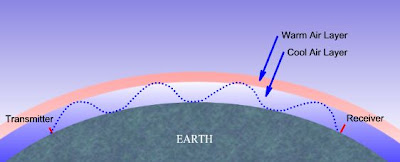 The wind shear theory says that gaseous ions can accumulate and be concentrated into small, thin, patchy sheets by the combined actions of high-altitude winds and the earth's magnetic field. when this occurrs in the E layer of the ionosphere. These resulting "sheets" can attain the required ion density to reflect radio waves. The big key here is that they are not stationary. So even if you remain still, which stations skip, changes in both frequency and distance.
The wind shear theory says that gaseous ions can accumulate and be concentrated into small, thin, patchy sheets by the combined actions of high-altitude winds and the earth's magnetic field. when this occurrs in the E layer of the ionosphere. These resulting "sheets" can attain the required ion density to reflect radio waves. The big key here is that they are not stationary. So even if you remain still, which stations skip, changes in both frequency and distance.It gets more complicated when you see the reports that indicate the "clouds" are not parallell with the earth. i.e. the angle of reflection may alter the point of reception by over 30 degrees!
Tropospheric Ducting is completely different. Signals don't bounce and are not reflected. It's more like they are "bent." Cold air is more dense than warm air, so it has a higher refractive index. Normally cold air normaly being on top and the warm air on the bottom. The opposite of that is called a temperature inversion.
This happens when a weather front approaches a high pressure area. Cold air is forced down and warm air is forced up. The air temperature increases with the altitude instead of decreasing. Radio signals are guided through thsi path like air through a "duct." Note: Tropospheric ducting affects all frequencies and can push your signal 800 miles.
That still leaves tropospheric scatter and tropospheric refraction.... to be explained tomorrow!
That still leaves tropospheric scatter and tropospheric refraction.... to be explained tomorrow!




No comments:
Post a Comment